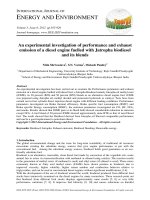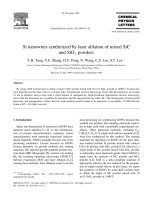- Trang chủ >>
- Khoa Học Tự Nhiên >>
- Vật lý
Silicon carbide nanowires synthesized with phenolic resin and silicon powders
Bạn đang xem bản rút gọn của tài liệu. Xem và tải ngay bản đầy đủ của tài liệu tại đây (690.06 KB, 4 trang )
Silicon carbide nanowires synthesized with phenolic resin
and silicon powders
Hongsheng Zhao
Ã
, Limin Shi, Ziqiang Li, Chunhe Tang
Division of New Materials, Institute of Nuclear and New Energy Technology, Tsinghua University, Beijing 102201, China
article info
Article history:
Received 13 October 2008
Received in revised form
10 December 2008
Accepted 11 December 2008
Available online 24 December 2008
PACS:
61.46.Àw
81.05.Je
Keywords:
Silicon carbide
Nanostructure
Scanning electron microscopy
High-resolution electron microscopy
abstract
Large-scale silicon carbide nanowires with the lengths up to several m illimeters were synthesized by a
coat-mix, moulding, carbonization, and high-temperature sintering process, using silicon powder and
phenolic resin as the starting materials. Ordinary SiC nanowires, bamboo-like SiC nanowires, and
spindle SiC nanochains are found in the fabricated samples. The ordinary SiC nanowire is a single-
crystal SiC phase with a fringe spacing of 0.252 nm along the [111] growth direction. Both of the
bamboo-like SiC nanowires and spindle SiC nanochains exhibit uniform periodic structures. The
bamboo-like SiC nanowires consist of amorphous stem and single-crystal knots, while the spindle SiC
nanochains consist of uniform spindles which grow uniformly on the entire nanowires.
& 2008 Elsevier B.V. All rights reserved.
1. Introduction
Since the discovery of carbon nanotubes (CNTs) in 1991,
increasing attention has been given to nanometer-scaled one-
dimensional materials because of their unique properties and
wide variety of potential applications [1–5]. Silicon carbide (SiC)
possesses a range of excellent physical, chemical, mechanical, and
electronic properties. These properties make SiC nanowires an
attractive candidate material for many applications, such as
reinforcement material, catalysis supports, and next-generation
high-temperature, high-power, and high-frequency electronic
devices [6–8].
Various methods have been reported to fabricate SiC nano-
wires. One-dimension SiC nanotubes and nanowires with various
shapes and structures have been synthesized at different
temperatures using carbon nanotubes as templates [9]. Pan
et al. [10] have successfully synthesized oriented SiC nanowires
by reacting aligned carbon nanotubes template with SiO. These
oriented nanowires may have promising applications for vacuum
microelectronic devices due to their excellent field emission
performances. Core–shell SiC/SiO
2
nanowires have been success-
fully fabricated by directly heating the NiO-catalysed silicon
substrate under reductive environments using the carbothermal
reduction [11]. Helical crystalline core–shell SiC/SiO
2
nanowires
and amorphous SiC nanosprings have also been synthesized by a
chemical vapor deposition technique [12,13]. A screw-dislocation-
induced growth mechanism was proposed for the formation of the
novel structure. Hao et al. [14] have prepared beaded SiC
nanochains, which consist of a stem and uniform beads. A simple
chemical vapor deposition route has been employed to fabricate
BN-nanotube-encapsulated SiC nanowires which possess an
unusual gap between the BN-nanotube sheath and the SiC core
[15,16]. They have also developed an efficient route to synthesize
coaxial nanocables composed of a single-crystalline SiC core, an
amorphous SiO
2
intermediate layer, and a graphitic carbon outer
sheath [17]. Carbon-rich SiC nanowires have been synthesized by
a method, which is based on the ability to form and manipulate
the properties of ethyl alcohol nanometer-sized bridges [18].
Electrospun PAN fibers have been employed as templates to
fabricate SiC nanowires with a uniform cross-section, well-
ordered structure, and a very low concentration of stacking faults
[19]. Niu and Wang [20,21] synthesized scales of high-quality
crystalline silicon carbide nanowires with small diameters by
direct thermal evaporation of ferrocene or ZnS onto a silicon wafer
at high temperature. This kind of SiC nanowires possessed a
uniform size, crystalline structure, and a thin oxide layer. A
tentative growth model according to the vapor–liquid–solid (VLS)
mechanism was also proposed.
b
-SiC nanowires can also be
directly synthesized by heating single-crystal silicon wafer and
graphite without metal catalysts [22]. The diameter of SiC
ARTICLE IN PRESS
Contents lists available at ScienceDirect
journal homepage: www.elsevier.com/locate/physe
Physica E
1386-9477/$ - see front matter & 2008 Elsevier B.V. All rights reserved.
doi:10.1016/j.physe.2008.12.005
Ã
Corresponding author. Tel./fax: +8610 89796090.
E-mail address: (H. Zhao).
Physica E 41 (2009) 753–756
nanowires is in the range of 10–30 nm, and the length is up to a
few millimeters. The protective gas, the high temperature, the
closed space, and the slow-cooling rate are key factors for the
formation of
b
-SiC nanowires.
This paper proposed a method to synthesize SiC nanowires
with phenolic resin and silicon powders without using any metal
catalysts. The advantages of this method are as follows: (1) The
process is simple and the starting materials are commercially
available. Therefore, SiC nanowires can be fabricated at a low cost.
(2) SiC nanowires can be produced in a relatively high quantity.
(3) Three types of SiC nanowires can be obtained. (4) The lengths
of the SiC nanowires can be up to several millimeters. (5) No metal
catalysts are required during the fabrication of SiC nanowires.
2. Experimental
The preparation of SiC nanowires includes the following steps:
(1) As is described in our previous work [23], precursor powders,
core/shell silicon/phenolic resin powders, were fabricated by
coating each silicon powder with a homogeneous phenolic resin
shell. (2) The obtained precursor powders were pressed to form
cylindrical green compacts. (3) The as-prepared green compacts
were subsequently heated at 800 1C in Ar atmosphere to get
carbonized compacts. (4) The carbonized compacts, which were
held in a graphite crucible with a graphite lid, were sintered in a
graphite furnace in Ar atmosphere. Here, the graphite lid is used
as the substrate to grow SiC nanowires. The sintering temperature
was 1500 1C. A soaking time of 2 h was sufficient to synthesize a
large quantity of SiC nanowires.
X-ray diffraction (XRD) patterns of the prepared nanowires
were recorded on a Japan D/max-IIIA X-ray diffractometer using
standard Cu K
a
radiation. A Hitachi S-3000N SEM operated at an
accelerating voltage of 10 KV was employed to investigate the
morphology of the products. Further structure characterization
and selected area electron diffraction (SAED) patterns were
performed on a Tecnai TF20 high-resolution transmission electron
microscopy (HRTEM) operated at 200 KV. During the HRTEM
sample preparation, the nanowires were first dispersed in ethanol
under ultrasonic vibration over 15 min and then placed onto
standard carbon-coated copper grids.
3. Results and discussion
It can be observed obviously that the as-synthesized sample on
the graphite lid is a light green fluffy material and the wires have
the length of up to several millimeters. SEM image shown in Fig. 1
reveals that most of the materials are wire-like structures with
diameters in the nanometer range. At the same time, it can be
found that the nanowires have several types of structure. This can
be further evidenced by the TEM analysis.
The XRD pattern shown in Fig. 2 verifies that the fabricated
sample is cubic
b
-SiC. Moreover, the stronger (111) diffraction
peak indicates that the [111] is the dominant growth direction of
the SiC nanowires.
Using HRTEM, we found that the fabricated SiC nanowires can
be grouped into three types of one-dimension structures. They are
described as follows:
(1) Ordinary SiC nanowires, as is indicated by (1) in Fig. 3a: this
figure presents a typical morphology of the ordinary SiC
nanowires. Most of the synthesized nanowires belong to this
structure. They are uniform in diameter along their entire
length. The HRTEM lattice image and SAED pattern shown in
Fig. 4 indicate that the single-crystal SiC nanowire with a
fringe spacing of 0.252 nm grows along the [111] direction. It
is known that, among the SiC surfaces, the {111} surfaces
have the lowest surface energy [24]. Thus, when the SiC
ARTICLE IN PRESS
Fig. 1. A typical SEM image of SiC nanowires.
Fig. 2. XRD pattern of SiC nanowires.
Fig. 3. A typical morphology of the ordinary SiC nanowires: (a) bamboo-like
structure and (b) spindle nanochain structure.
H. Zhao et al. / Physica E 41 (2009) 753–756754
nanowires grow parallel to the {111} surfaces, the system’s
energy can be reduced significantly. It also shows that the SiC
nanowire is covered with a continuous SiO
2
amorphous layer
with a thickness of 1 nm, which is probably formed during the
TEM sample preparation.
(2) Bamboo-like SiC nanowires as is indicated by (2) in Fig. 3a:
this figure presents a TEM image of the bamboo-like SiC
nanowire with a stem diameter of about 40 nm. Larger
diameter knots, like bandages wrapped around the nanowires,
grow periodically along the entire length of the bamboo-like
SiC nanowire. The knots possess a high density of stacking
faults which are perpendicular to the axis of the bamboo-like
SiC nanowire. The formation of these stacking faults is
generally thought to be attributed to the thermal stress
during the nanowire growth [25]. However, it is interesting to
find that the stacking faults only exist in the knots instead of
the whole bamboo-like SiC nanowire.
(3) Fig. 5a and b shows the HRTEM lattice images taken from the
area marked with circles (S and K) in Fig. 3a, corresponding
to the stem and knot of the bamboo-like SiC nanowire,
respectively. Fig. 5a suggests that the stem of the bamboo-like
SiC nanowire is amorphous SiC without stacking faults and
planar defects. This can be confirmed by the corresponding
SAED pattern shown in Fig. 5c. It can be found from Fig. 5b
that the knots are single-crystalline
b
-SiC with a fringe
spacing of 0.252nm, which corresponds well to the {111}
plane of cubic
b
-SiC. Stacking faults exist in the whole knot.
This can be further evidenced by the SAED pattern of the knot
(recorded from the area marked with circled K in Fig. 3a)
shown in Fig. 5d. The SAED pattern of the knot shows
bright spots and streaks, indicating that defects exist in the
knot area.
(4) Spindle SiC nanochains: this type of SiC nanowires also has a
uniform periodic structure. As is indicated by (3) in Fig. 3b, the
spindle nanochain possesses a thinner stem with a diameter
of 20 nm and uniform spindles with a diameter of 50 nm. The
distance between two neighboring spindles is about 250 nm.
Therefore, the period of the spindle nanochain can be
regarded as 250 nm. Similar to the beaded SiC nanochains
reported in Ref. [14], the mechanical interlocking between
spindles can enhance the interfacial adhesion between the
nanochains and the matrix. Thus, the unusual morphology of
spindle SiC nanochains may endow them with an excellent
reinforcing effect. By simply laying the spindle SiC nanochains
on a flat metal surface, a high density of semiconductor–metal
junctions can be easily fabricated.
4. Conclusions
In summary, we have demonstrated a process for the
fabrication of SiC nanowires with three distinct structures,
by using commercially available phenolic resin and silicon
powders as starting materials. The first type of SiC nanowire,
regarded as ordinary SiC nanowire, is single-crystal SiC phase
with a fringe spacing of 0.252 nm along the [111] growth
direction. The second type of SiC nanowire, namely bamboo-like
SiC nanowire, possesses amorphous SiC stem decorated periodi-
cally by larger diameter single-crystal SiC knots along its whole
length. The third type of SiC nanowire, spindle SiC nanochain,
consists of uniform spindles which grow evenly on its entire
length. These nanowires may find applications in composite
materials or electronic devices. Given the simplicity of the
procedures and the unique morphology of the synthesized
materials, the method described here would attract a great deal
of attention.
Acknowledgments
The authors would like to acknowledge the National Natural
Science Foundation of China (contract No. 50802052) and the Key
Faculty Support Program of Tsinghua University for providing
financial support.
References
[1] S. Iijima, Nature 354 (1991) 56.
[2] Z.L. Xiao, C.Y. Han, U. Welp, H.H. Wang, W.H. Kwok, G.A. Willing, J.M. Hiller,
R.E. Cook, D.J. Miller, G.W. Crabtree, Nano Lett. 2 (2002) 1293.
[3] M. Law, L.E. Greene, J.C. Johnson, R. Saykally, P.D. Yang, Nat. Mater. 4 (2005)
455.
[4] Z. Xiao, L. Zhang, X. Tian, X. Fang, Nanotechnology 16 (2005) 2647.
[5] H.F. Zhang, A.C. Dohnalkova, C.M. Wang, J.S. Young, E.C. Buck, L.S. Wang, Nano
Lett. 2 (2002) 105.
[6] T. Ishikawa, Y. Kohtoku, K. Kumagawa, T. Yamamura, T. Nagasawa, Nature 391
(1998) 773.
ARTICLE IN PRESS
Fig. 4. HRTEM lattice image and SAED pattern of SiC nanowires.
Fig. 5. The HRTEM lattice images and SAED pattern taken from the area marked in
Fig. 3a.
H. Zhao et al. / Physica E 41 (2009) 753–756 755
[7] D. Nakamura, I. Gunjishima, S. Yamaguchi, T. Ito, A. Okamoto, H. Kondo,
S. Onda, K. Takatori, Nature 430 (2004) 1009.
[8] R. Madar, Nature 430 (2004) 974.
[9] X.H. Sun, C.P. Li, W.K. Wong, N.B. Wong, C.S. Lee, S.T. Lee, B.K. Teo, J. Am. Chem.
Soc. 124 (2002) 14464.
[10] Z. Pan, H. Lai, F.C.K. Au, X. Duan, W. Zhou, W. Shi, N. Wang, C. Lee, N. Wong,
S. Lee, S. Xie, Adv. Mater. 12 (2002) 1186.
[11] Y. Ryu, Y. Tak, K. Yong, Nanotechnology 16 (2005) S370.
[12] H.F. Zhang, C.M. Wang, L.S. Wang, Nano Lett. 2 (2002) 941.
[13] D. Zhang, A. Alkhateeb, H. Han, H. Mahmood, D.N. Mcllory, Nano Lett. 3
(2003) 983.
[14] Y.J. Hao, J.B. Wagner, D.S. Su, G.Q. Jin, X.Y. Guo, Nanotechnology 17 (2006)
2870.
[15] Y.B. Li, P.S. Dorozhkin, Y. Bando, D. Golberg, Adv. Mater. 17 (2005) 545.
[16] C. Tang, Y. Bando, T. Sato, K. Kurashima, Adv. Mater. 1 (2002) 1046.
[17] Y.B. Li, Y. Bando, D. Golberg, Adv. Mater. 16 (2004) 93.
[18] M. Tello, R. Garcia, J.A. Martingago, N.F. Martinez, M.S. Martin, L. Aballe,
A. Baranov, L. Gregoratti, Adv. Mater. 17 (2005) 1480.
[19] H. Ye, N. Titchenal, Y. Gogotsi, F. Ko, Adv. Mater. 17 (2005) 1531.
[20] J.J. Niu, J.N. Wang, Eur. J. Inorg. Chem. 25 (2007) 4006.
[21] J.J. Niu, J.N. Wang, J. Phys. Chem. B 111 (2007) 4368.
[22] X.W. Du, X. Zhao, S.L. Jia, Y.W. Lu, J.J. Li, N.Q. Zhao, Mater. Sci. Eng. B 136
(2007) 72.
[23] L.M. Shi, H.S. Zhao, Y.H. Yan, Z.Q. Li, C.H. Tang, Powder Technol. 169 (200 6) 71.
[24] S. Zhu, D. Xi, Q. Li, R. Wang, J. Am. Ceram. Soc. 88 (2005) 2619.
[25] G. Shen, Y. Bando, C. Ye, B. Liu, D. Golberg, Nanotechnology 17 (2006) 3468.
ARTICLE IN PRESS
H. Zhao et al. / Physica E 41 (2009) 753–756756









